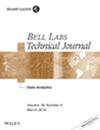Jean-Pierre Bonin, Cengiz Evci, Amy L. Sanders
下载PDF
{"title":"Securing Spectrum Through the ITU to Fuel the Growth of Next-Generation Wireless Technologies","authors":"Jean-Pierre Bonin, Cengiz Evci, Amy L. Sanders","doi":"10.1002/bltj.21607","DOIUrl":null,"url":null,"abstract":"<p>Mobile data traffic is increasing exponentially and the ability of mobile broadband (MBB) technologies, such as Long Term Evolution-Advanced (LTE-A), to meet this demand depends on the availability of spectrum beyond that which is currently available to cellular mobile systems. This additional spectrum will be needed even considering the gains that will be delivered by LTE and LTE-A's higher spectral efficiency and the use of cell densification. Allocating and making spectrum available on a global basis is a complex process that is managed by the International Telecommunication Union (ITU) on a worldwide scale. Alcatel-Lucent and the wider mobile industry are working to harmonize this spectrum as much as possible to improve economies of scale for mobile broadband technologies and products. This paper describes the current “spectrum crunch,” the spectrum allocation process, steps being taken to make more effective use of available spectrum, and the challenges in making additional spectrum available for the success of next-generation wireless networks. © 2013 Alcatel-Lucent.</p>","PeriodicalId":55592,"journal":{"name":"Bell Labs Technical Journal","volume":"18 2","pages":"99-115"},"PeriodicalIF":0.0000,"publicationDate":"2013-08-28","publicationTypes":"Journal Article","fieldsOfStudy":null,"isOpenAccess":false,"openAccessPdf":"https://sci-hub-pdf.com/10.1002/bltj.21607","citationCount":"3","resultStr":null,"platform":"Semanticscholar","paperid":null,"PeriodicalName":"Bell Labs Technical Journal","FirstCategoryId":"1085","ListUrlMain":"https://onlinelibrary.wiley.com/doi/10.1002/bltj.21607","RegionNum":0,"RegionCategory":null,"ArticlePicture":[],"TitleCN":null,"AbstractTextCN":null,"PMCID":null,"EPubDate":"","PubModel":"","JCR":"Q1","JCRName":"Engineering","Score":null,"Total":0}
引用次数: 3
引用
批量引用
Abstract
Mobile data traffic is increasing exponentially and the ability of mobile broadband (MBB) technologies, such as Long Term Evolution-Advanced (LTE-A), to meet this demand depends on the availability of spectrum beyond that which is currently available to cellular mobile systems. This additional spectrum will be needed even considering the gains that will be delivered by LTE and LTE-A's higher spectral efficiency and the use of cell densification. Allocating and making spectrum available on a global basis is a complex process that is managed by the International Telecommunication Union (ITU) on a worldwide scale. Alcatel-Lucent and the wider mobile industry are working to harmonize this spectrum as much as possible to improve economies of scale for mobile broadband technologies and products. This paper describes the current “spectrum crunch,” the spectrum allocation process, steps being taken to make more effective use of available spectrum, and the challenges in making additional spectrum available for the success of next-generation wireless networks. © 2013 Alcatel-Lucent.
通过国际电联保护频谱,推动下一代无线技术的发展
移动数据流量呈指数级增长,移动宽带(MBB)技术(如长期演进-高级(LTE-A))满足这一需求的能力取决于蜂窝移动系统目前可用的频谱之外的可用性。即使考虑到LTE和LTE- a更高的频谱效率和使用小区密度将带来的增益,也需要这些额外的频谱。在全球范围内分配和提供频谱是一个复杂的过程,由国际电信联盟(ITU)在全球范围内进行管理。阿尔卡特朗讯和更广泛的移动行业正在努力尽可能地协调这一频谱,以提高移动宽带技术和产品的规模经济。本文描述了当前的“频谱紧缩”、频谱分配过程、为更有效地利用可用频谱而采取的步骤,以及为下一代无线网络的成功提供额外频谱所面临的挑战。©2013阿尔卡特朗讯
本文章由计算机程序翻译,如有差异,请以英文原文为准。

 求助内容:
求助内容: 应助结果提醒方式:
应助结果提醒方式:


